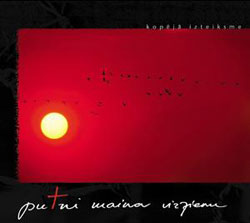
The musical output of Latvia has become more and more varied through recent years. Beyond the standard styles of rock and folk, other styles like dance, techno, rap, and rhythm and blues have been heard being played by Latvian groups. Some styles are particularly hard to define. One example is the group Kopējā izteiksme and their release Putni maina virzienu. One would be quick to label it as "New Age," but it does not fit neatly into that category.
It is an entirely instrumental album, full of textured sounds and many different kinds of instruments. It is very heavy on synthesizers (maybe a bit much so), but a varied lineup of musicians keep the album from sounding overly synthesized. It is also very atmospheric, complete with ocean sounds. Much of the music sounds like it belongs in a film sountrack.
The main musicians in Kopējā izteiksme are Jānis Brūveris (on keyboards and programming, as well as composer of eight of the 11 tunes on the album), and Ainārs Paukšēns (also on keyboards and programming, as well as the cello). Joining them are Michael Nagy on acoustic guitar, Juris Kulakovs on accordion and Artis Gāga on saxaphone. Also appearing is a string quartet, made up of Lāsma Muceniece on violin, Signe Šteimane on violin, Jānis Lielbārdis on viola and Paukšēns on cello.
As with many "New Age" groups, Kopējā izteiksme’s music is very influenced by nature. One of the main themes of the album is about birds, their ability to know where to fly when they migrate and how they know where to return to.
Of note is that there is nothing particularly "Latvian" about the music, besides the fact that it was produced by Latvian musicians.
The album opens up with "Tuvums," which starts off with a very pretty introduction on acoustic guitar.
The song "Pirmais gads" reminds me a bit of the music of the Indians of South America (the kind who always seem to be playing in the Times Square subway station), mainly due to the synthesized, flute-like sound.
"Sniegs (akustiskais mix)" with its piano theme, is a particularly haunting song, simple but eerie. It reminds me of the theme to the Halloween horror movies. The strings provide a nice balance to the piano melody.
This theme returns in "Sniegs (paplašinātais mix)," which for the most part is simply an extended version of the original, but diverges near the end, where bass and drum sounds are added.
My favorite track on the recording is probably "No sevis sāc," perhaps because it sounds more like an actual "song" (but without words, of course) and has a melody that can be hummed along with. I particularly like the way the acoustic guitar sounds in it.
The album packaging is on the simple side, with the obligatory nature pictures in it. Text relating to the theme of the album asks Zen-like cosmic questions such as "Kur putni maina virzienu? Tu zini? Un kāpēc? Tu zini? Pastāsti man!" (Where do birds change direction? Do you know? And why? Do you know? Tell me!)
Putni maina virzienu is a great-sounding album, full of many styles and textures. It is a pleasant listen when one needs more mellow music to relax with. Listening to this music will make people light up their incense and start meditating. But it is not the kind of recording that I would buy. Listening to the album made me sleepy (but perhaps that is one of the intentions of the artists). Enough variety is on the album for fans of this genre, though it does seem at times that a few of the pieces on the album start to sound very similar.
As with many of these kinds of recordings, the human aspect is missing. The music sounds very "mechanical" at times, as though it was entirely performed by a machine (which I’m sure a lot of it was, because both Paukšēns and Brūveris are credited with “programming”). However, if you like your music atmospheric and heavy on the synthesizer sound, then you will most likely like Putni maina virzienu.
Details
Putni maina virzienu
Kopējā izteiksme
Latvijas Radio, 2000
© 1995-2024 Latvians Online
Please contact us for editorial queries, or for permission to republish material. Disclaimer: The content of Web sites to which Latvians Online provides links does not necessarily reflect the opinion of Latvians Online, its staff or its sponsors.




